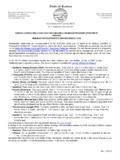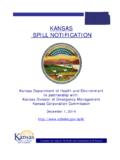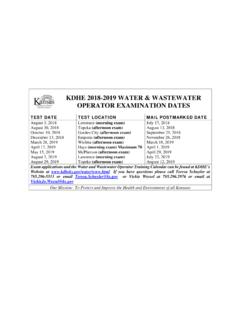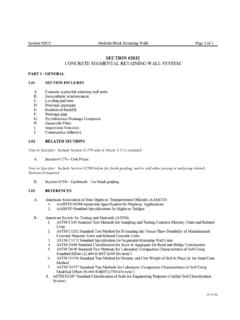Transcription of Leak - KDHE
1 Chapter 5 Soil Drainage Systems Introduction and Back~ound Natural soil drainage materials are used extensively in waste containment units. The most common uses are: 1. Drainage layer in final cover system to reduce the hydraulic head on the underlying barrier layer and to enhance slope stability by reducing seepage forces in the cover system. 2. Gas collection layer in final cover systems to channel gas to vents for controlled removal of potentially dangerous gases. 3. Leachate collection layer in liner systems to remove leachate for treatment and to remove precipitation from the disposal unit in areas where waste has not yet been placed. 4. Leak detection layer in double liner systems to monitor performance of the primary liner and, if necessary, to serve as a secondary leachate collection layer. 5. Drainage trenches to collect horizontally-flowing fluids, , ground water and gas.
2 Drainage layers are also used in miscellaneous ways, such as to drain liquids from backfill behind retaining walls or to relieve excess water pressure in critical areas such as the toe of slopes. Materials Soil drainage systems are constructed of materials that have high hydraulic conductivity. High hydraulic conductivity is not only required initially, but the drainage material must also maintain a high hydraulic conductivity over time and resist plugging or clogging. The hydraulic conductivity of drainage materials depends primarily on the grain size of the finest particles present in the soil. An equation that is occasionally used to estimate hydraulic conductivity of granular materials is Hazen's formula: where k is the hydraulic conductivity (cm/s) and Dl0 is the equivalent grain diameter (mm) at which 10% of the soil is finer by weight.
3 To determine the value of D10, a plot is made of the grain-size distribution of the soil (measured following ASTM D-422) as shown in Fig. The equivalent grain diameter (Dlo) is determined from the grain size distribution curve as shown in Fig. Experimental data verify that the percentage of fine material in the soil dominates hydraulic conductivity. For example, the data in Table illustrate the influence of a small amount of fines upon the hydraulic conductivity of a filter sand . The addition of just a few percent of fine material to a drainage material can reduce the hydraulic conductivity of the drainage material by 100 fold or more. 0 Smaller Size 0 Larger Size Mean Grain Diameter (Log Scale) Figure - Grain Size Distribution Curve Construction specifications usually stipulate a minimum hydraulic conductivity for the drainage layer.
4 The value specified varies considerably from project to project but is typically in the range of to 1 crnls. The method used to determine hydraulic conductivity in the laboratory is ASTM D-2434. Table Effect of Fines on Hydraulic Conductivity of a Washed filter Aggregate (from Cedergren, 1989) Percent Passing No. 100* Sieve Hydraulic Conductivity (cmls) *Opening size is mm. Drainage materials may also be required to serve as filters. For instance, as shown in Fig. , a filter layer may be needed to protect a drainage layer from plugging. The filter layer must serve three functions: 1. The filter must prevent passage of significant amounts of soil through the filter , . , the filter must retain soil. 2. The filter must have a relatively high hydraulic conductivity, , the filter should be more permeable than the adjacent soil layer.
5 3. The soil particles within the filter must not migrate significantly into the adjacent drainage layer. filter specifications vary somewhat, but the design procedures are similar. The determination of requirements for a filter material proceeds as follows: 1. The grain size distribution curve of the soil to be retained (protected) is determined following procedures outlined in ASTM D-422. The size of the protected soil at which 15% is finer (D15, soil) and 85% is finer (D85, soil) is determined. 2. Experience shows that the particles of the protected soil will not significantly penetrate into the filter if the size of the filter at which 15% is finer @is, filter ) is less than 4 to 5 times Dg5 of the protected soil: D15, filter 5 (4 to 5) D85, soil ( ) Experience shows that the hydraulic conductivity of the filter will be significantly greater than that of the protected soil if the following criterion is satisfied: Dl5, filter 14 D15, soil ( ) To ensure that the particles within the filter do not tend to migrate excessively into the drainage layer, the following criterion may be applied: Dl5, drain5 (4 to 5) D15, filter ( ) 5.
6 Experience shows that the hydraulic conductivity of the drain will be significantly greater than that of the filter if the following criterion is satisfied: Dl5, drain 2 4 D15, filter ( ) filter design is complicated significantly by the presence of biodegradable waste materials, , municipal solid waste, directly on top of the filter . In such circumstances, the usual filter criteria may be modified to satisfy site-specific requirements. Some degree of reduction in hydraulic conductivity of the filter layer may be acceptable, so long as the reduction does not impair the ability of the drainage system to serve its intended function. A laboratory test method to quantify the hydraulic properties of both soil and geotextile filters that are exposed to leachate is ASTM D-1987. However, regardless of specific design criteria, the gradational characteristics of the filter material control the behavior of the filter .
7 CQCICQA personnel should focus their attention on ensuring that the drainage material and filter material meet the grain-size-distribution requirements set forth in the construction specifications, as well as other specified requirements such as mineralogy of the materials. Soil Laver ~hose~articles~ust Not filter Layer to Prevent Migration I of Soil Particles into Drainage Layer Figure - filter Layer Used to Protect Drainage Layer from Plugging 194 Control of Materials The recommended procedure for verifying the hydraulic conductivity for a proposed drainage material is as follows. Samples of the proposed material should be obtained and shipped to a laboratory for testing. Samples should be compacted in the laboratory to a density that will be representative of the density to be used in the field. Hydraulic conductivity should be measured following procedures in ASTM D-2434 and compared with the required minimum values stated in the construction specifications.
8 If the hydraulic conductivity exceeds the minimum value, the material is tentatively considered to be acceptable. However, it should be realized that the process of excavating and placing the drainage material will cause some degree of crushing of the drainage material and will produce additional fines. Thus, the construction process itself tends to increase the amount of fines in the drainage material and to decrease the hydraulic conductivity of the material. If the drainage material just barely meets the hydraulic conductivity requirements stated in the construction specifications from initial tests, there is a good possibility that the material will fail to meet the required hydraulic conductivity standard after the material has been placed. As a rule of thumb, approximately one-half to one percent of additional fines by weight will be generated every time a drainage material is handled, , one-half to one percent additional fines would be generated when the drainage layer material is excavated and an additional one-half to one percent of fines would be generated when the material is placed.
9 Also, the reproducibility of hydraulic conductivity tests is not well established; a material may just barely meet the hydraulic conductivity standard in one test but fail to meet minimum requirements in another test. Finally, if the drainage materials are found to be suitable prior to placement but unsuitable after placement, an extremely difficult situation arises -- it is virtually impossible to remove and replace the drainage material without risking damage to underlying geosynthetic components, , a geomembrane. Therefore, some margin of safety should be factored into the selection of drainage material. Because it is extremely difficult to remove and replace a drainage material without damaging an underlying geosynthetic component, testing of the drainage material should occur prior to placement of the material.
10 The CQC personnel should have a high degree of confidence that the drainage material is suitable prior to placement of the material. Because the construction process may alter the characteristics of the drainage material, it is important that CQA tests also be performed on the material after it has been placed and compacted (if it is compacted). The usual tests involve determination of the grain size distribution of the soil (ASTM D- 422) and hydraulic conductivity of the soil (ASTM D-2434). Hydraulic conductivity tests tend to be time consuming and relatively difficult to reproduce precisely; the test apparatus that is employed, the compaction conditions for the drainage material, and other details of testing may significantly influence test results. Grain-size distribution analyses are simpler. Therefore, it is recommended that the CQA testing program emphasize grain-size distribution analyses, with particular attention paid to the amount of fines present in the drainage material, rather than hydraulic conductivity testing.













